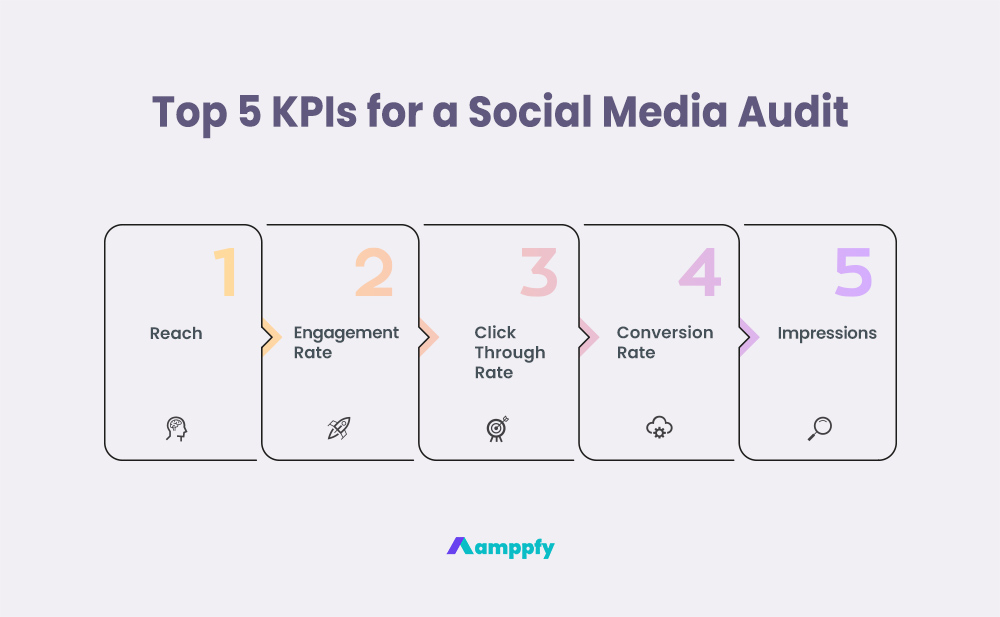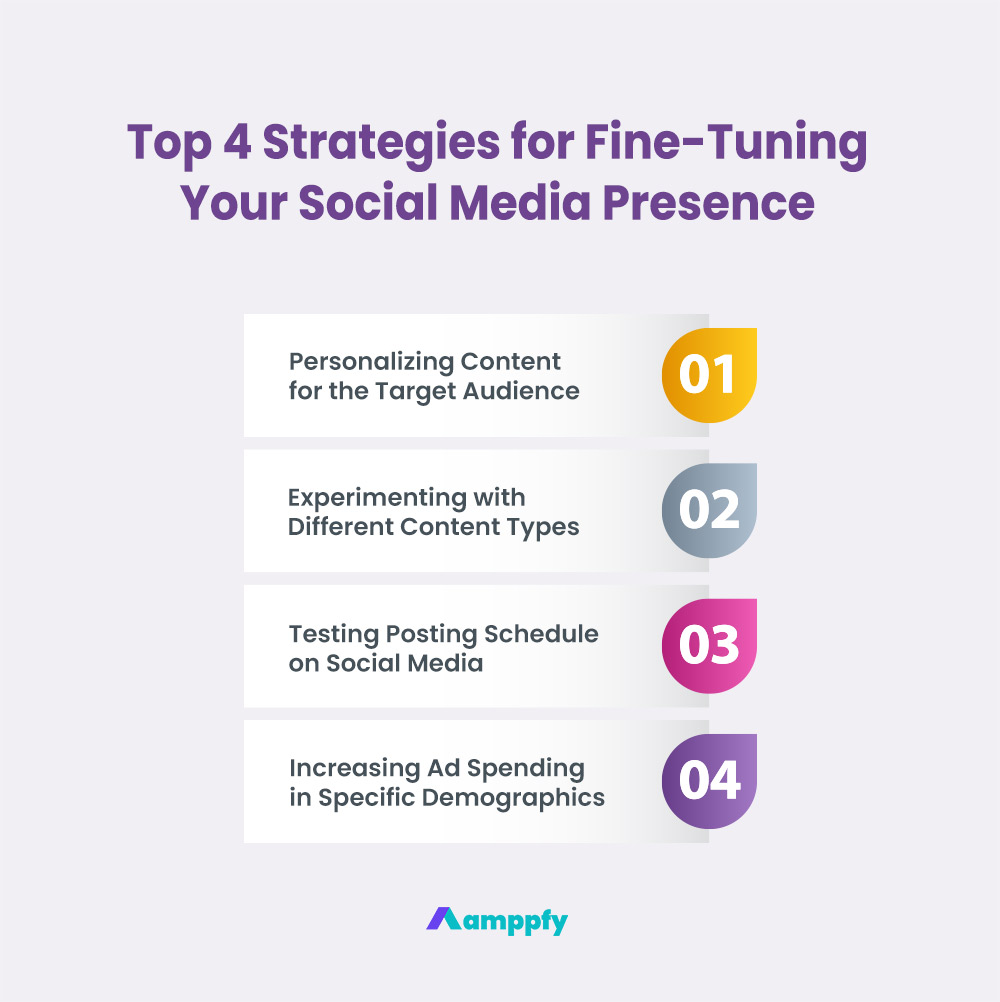To optimize your social media presence and maximize the digital marketing playbook potential, it is crucial to conduct a thorough social media audit periodically. Let’s walk through the process of completing a comprehensive social media audit to fine-tune marketing strategies and set yourself apart from the competition.
What is Social Media Audit?
A social media audit systematically examines and evaluates your brand’s social media presence and performance. It involves analyzing the current strategies, content, and metrics to gain valuable insights and identify areas for improvement. Conducting a social media audit assesses how effectively the social media game plan aligns with the business goals, identifies content gaps, and better understands your audience.
Analyze Social Media Profiles
During a social media audit, probe into various aspects of your social media presence, including analyzing your profiles on different platforms such as Facebook, Instagram, LinkedIn, YouTube, and X (formerly Twitter). Assess the consistency and effectiveness of the brand messaging across these platforms, evaluating how well it resonates with the target audience.
Analyze Historical Social Media Posts and Content
The social media audit involves a comprehensive review of the content strategy, examining the content types you publish, the frequency of posts, and the engagement levels they generate. This analysis determines which content formats and topics most successfully capture the audience’s attention and drive meaningful interactions.
Analyze KPI Metrics that are Important to Your Business
Metrics play a crucial role in a social media audit. Examine key performance indicators (KPIs) such as the following.
Top 5 KPIs for a Social Media Audit

- Reach
- Engagement rate
- Click-through rate
- Conversion rate
- Impressions
Understanding these metrics enables you to assess the impact of social media efforts on the overall marketing objectives, identify gaps in the KPI metrics, and make necessary adjustments to ensure accurate data tracking and reporting.
Benchmark the Social Media Audit Against Competitors
A social media audit provides an opportunity to assess your competitors’ social media presence. By benchmarking against industry leaders and analyzing their strategies, you gain insights into emerging trends, identify potential growth opportunities, and refine the approach. This competitive analysis helps you stay ahead in the ever-evolving social media landscape.
Analyze the Audience, Demographic, and Behavior Data
Delve into your social media followers’ demographics, interests, and behaviors. Understanding the audience’s preferences and motivations enables better tailoring of content to fit their needs and expectations, ultimately fostering stronger connections and driving higher engagement.
Set a Schedule for Social Media Auditing
Social media audit is not a one-time activity. It should be conducted regularly to keep up with the dynamic nature of social media platforms and changing consumer behaviors. You can better align strategies, experiment with new approaches, and continuously optimize performance by consistently evaluating your social media presence.
Breaking down the audit into manageable tasks and setting deadlines helps you stay organized and ensures the necessary aspects of social media presence are covered. This timeline includes tasks such as reviewing content, analyzing engagement metrics, and identifying areas for improvement.
How to Prepare for a Social Media Audit
It is essential to lay the groundwork for success before going into the audit process. Start by clearly defining the objectives for the audit and what you hope to achieve. Is the primary focus boosting brand awareness, driving website traffic, or increasing engagement? Identify proper goals to stay focused throughout the audit and prioritize efforts.
It is also crucial to understand the current state of your social media presence. Take the time to gather information about your existing social media accounts, such as the following.
Top 4 Important Metrics for Running a Social Media Audit

- Number of followers or subscribers gained or lost
- Frequency of posting
- Level of audience engagement
- Social media sourced website visitors
This baseline data will serve as a reference point for measuring the effectiveness of your future social media campaigns.
Include Key Stakeholders in the Social Media Audit Process
Collaborating with team members from cross-functional teams, such as marketing, sales, product, and customer service, provides diverse perspectives and ensures that all aspects of the social media strategy are considered. Their input and expertise can contribute to a comprehensive and effective audit.
Identify Goals and Objectives
Setting clear goals and objectives is the first step towards a successful social media audit. Without a defined set of objectives, the audit becomes a mere surface-level analysis without actionable insights. Goals should be specific, measurable, attainable, relevant, and time-bound (SMART). For example, a goal could be to increase your Instagram engagement rate by 20% within the next three months.
Once you have established a set of clearly defined goals, align them with the broader marketing objectives and KPIs to ensure the social media efforts are contributing directly to the overall success of the marketing campaigns.
Analyze Your Current Social Media Presence
Start by mapping out all of your brand’s social media platforms and accounts. Take note of the follower counts, engagement metrics, and any paid advertising campaigns that are currently running. Analyze the type of content you have been posting across different social media channels, and consider the following.
Top 3 Metrics to Consider When Analyzing Content for Social Media Audit
- Is the content consistent with your brand’s voice and identity?
- Do you have a strong visual presence on social media?
- Are you effectively utilizing different content formats, such as images, videos, and infographics?
During the analysis, focus on audience demographics and social media behavior. Dive deep into the analytics to understand who your followers are, what content resonates with them, and when they are most active. This information helps tailor social media strategies to better reach and engage the target audience.
Evaluate the Competitor’s Social Media Performance
Staying ahead of the competition is crucial in the ever-evolving world of social media marketing. Take the time to analyze your competitors’ social media strategies and performance to gain insights and identify potential areas of improvement.
Identify the leading competitors and thoroughly evaluate their social media presence. Look at the types of content they share, the engagement they receive, and any unique strategies they employ. Understanding what works for the competitors allows you to gain inspiration and adapt campaign strategies to fit your brand. Here are two competitor audit questions to consider.
Top 2 Social Media Audit Questions for Competitor Analysis
- Are your competitors effectively responding to comments and messages?
- How do your competitors handle customer inquiries and complaints?
Make Adjustments and Further Optimize the Social Media Strategy
Based on the insights gathered from your social media audit, it’s time to make adjustments and optimize your social media strategy. Implement the necessary changes below.
Top 4 Strategies for Fine-Tuning Your Social Media Presence

- Personalizing the content to cater to the target audience
- Experimenting with different content types on social media
- Testing posting schedule on social media
- Increasing ad spending in specific target demographics with high engagement
It is important to note that optimization is an iterative process. Frequently measure and evaluate the impact of the changes you make, and be ready to pivot if needed. The key is continuously adapting and testing new strategies to find what works best for your brand and target audience.
Leverage Insights from the Social Media Audit
A social media audit is about improving your current strategies to provide valuable insights for future marketing playbooks. Use the data and learnings gathered throughout the audit process to improve the content creation, messaging, and targeting for upcoming campaigns.
For example, if you discover that certain types of content consistently outperform others, incorporate similar content into your future social media marketing strategies. If a specific social media platform resonates particularly well with the target audience, allocate more resources and efforts towards that channel.
Social Media Audit Best Practices for Marketing Campaigns
Keep in mind the best practices as you perform future social media audits.
- Regularly conduct audits to stay on top of industry trends and changes in audience behavior
- Ensure that the social media strategy aligns with your broader marketing objectives
- Track and analyze both quantitative and qualitative metrics to gain a holistic view of social media performance
- Stay informed about your competitors’ strategies and pivot as needed
- Continuously experiment and optimize the content, posting schedule, and engagement tactics
- Utilize social media analytics tools to measure and track your KPIs
- Share the insights and learnings from the social media audit with the broader team to foster collaboration and improve strategy alignment
As a last note, if your business has a local market presence, refer to our complete guide on how to boost your social media campaign results and ROI by leveraging the power of hyperlocal social media marketing.

